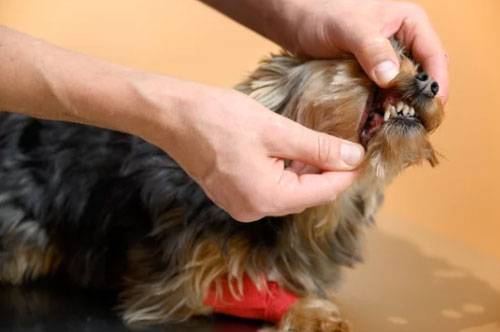Dogs can be affected with dental issues, but the problem remains unnoticed in many cases, until much later. Dogs are mostly affected with gum disease, which can lead to pain, loss of teeth, and other complications. Early diagnosis of the condition is crucial in understanding how to identify dental disease in your dog. It not only helps in limiting the damage and treating it, but also in minimizing your pet’s discomfort. Here’s what you need to look for in case of dental issues in dogs.

Symptoms of Dental Disease in Dogs
Drooling frequently
Drooling maybe a common dog’s thing, but it can be alarming, if it happens way too much. Dogs usually drool when they are expecting their favorite food, biting treats or other things. In case of an oral problem, their salivary glands become over stimulated and produce excess saliva. If you happen to see blood along with the saliva, it could indicate a very serious condition which requires immediate attention.
Bad breath
Dogs may not always have clean oral breath, given the things they chew, but if it gets extremely foul, then there may be a dental problem as a part of how to identify dental disease in your dog. Bad smell is often a symptom of cavity or infection and it can be discomforting for the dog.
Change in eating habits
You may notice that a once very enthusiastic dog has no interest in his favourite food anymore and eats much less than before. The dog may not be able to finish his bowl of food or may cry out in agony when chewing food. This change in food habits may be due to oral issues or other health conditions.
Prefers to chew on one side
If one or more of his teeth are affected, the dog may start chewing food on one side only, due to the pain. He may also keep spilling the contents of his mouth when eating.
Changes in behavior
When you try to pet your dog, he may shake it off and move away from you, fearing your hands may touch the sore areas around his mouth. The dog may become suddenly grumpy and may also try to bite at those trying to touch him. He may be hurting badly and so, the sudden change in behavior.
Changes in dog’s mouth
If your dog has any dental issues, you may be able to see the signs by taking a look at his mouth. The gums may be receding, inflamed or red. There may be cavities, broken or loosely hanging teeth.
Nasal discharge
In case of advanced periodontal disease in dogs, the upper teeth and bones can be severely affected, causing nasal discharge and frequent sneezes. Find more information about the signs of dental problems in dogs.





